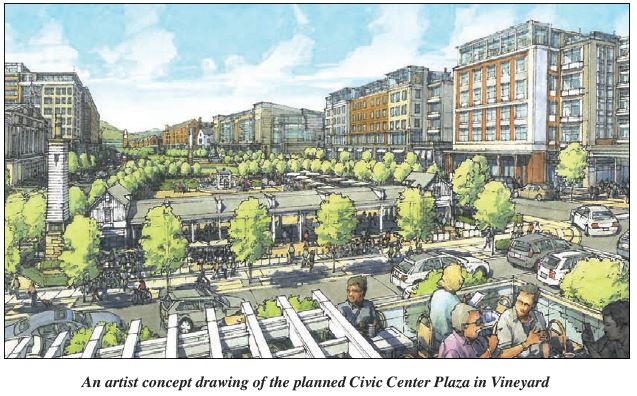By Julie Fullmer
Rethinking brick-and-mortar business will allow companies to survive the innovations being thrust upon them throughout the rise in technology and the adaptations required to evolve during this global pandemic.
Brick-and-mortar businesses have been experiencing fierce competition brought on by e-commerce players for years, and with the intense economic pressures brought on by the global response to COVID-19, there is the need for these businesses to adapt or die. Online retail growth has increased dramatically over the past eight years and was propelled at more significant rates this past year. Despite this trend, successful brick-and-mortar locations are still viable within proper settings.
 Brick-and-m-ortar businesses provide essential aspects of wellness and economics within cities. Businesses and cities both need to be able to efficiently shift models to meet the requirements of the pandemic, growing markets and other future needs.
Brick-and-m-ortar businesses provide essential aspects of wellness and economics within cities. Businesses and cities both need to be able to efficiently shift models to meet the requirements of the pandemic, growing markets and other future needs.
Rethinking city design can improve local businesses’ likely success and their interactions by strengthening their engagement with the communities they serve. Smart city design is one of Vineyard’s foundational cornerstones. Vineyard residents don’t have the typical “not-in-my-back-yard” mindset, but rather an educated understanding of the changes manifesting in Utah, and that idyllic versions of living, working and playing can be met with the right design in mind. This understanding brings support to the changes that must be met by municipalities in strong business markets and growing regions like Utah County.
An influencer of urban studies, sociology and economics, Jane Jacobs, said, “Cities have the capability of providing something for everybody, only because and only when they are created by everybody.”
Every long-term planning decision in Vineyard is packed with public opinion, think tanks of local and state key stakeholders, state and regional drivers of commerce and successful business leaders, modeling done by world-renowned engineering and design experts and deeply researched processes. This is part of the secret business sauce of Vineyard.
Vineyard has a keen eye on what city design means for businesses. Over the past decade, some of the clearest consumer trends reveal that retailers need to focus on tailored selections for shoppers, model experience over materialism and bring a sense of destination that is full of ease and convenience.
 Additionally, remote work and satellite office spaces are at the frontier of industry. People want to live where they can work, relax, recreate and indulge in nature and entertainment alike. Business headquarters need to model toward these trends and locate in cities that follow the same goals.
Additionally, remote work and satellite office spaces are at the frontier of industry. People want to live where they can work, relax, recreate and indulge in nature and entertainment alike. Business headquarters need to model toward these trends and locate in cities that follow the same goals.
Vineyard follows these specifications. Placing people and businesses together in a walkable mixed-use center where jobs, housing, higher education, wide-open spaces, world-class transportation and investments are coordinated in a travel destination is the Vineyard smart-city design model.
Smart-city planning focuses on design and connection. It creates a community that is “human scale,” meaning that everything is centered around people. Vineyard has removed the barriers of exclusive housing perimeters and provided strategic inclusive housing options that encourage multi-faceted lifestyles throughout the city and in the heart of the downtown. These developments are organized into mixed-use zoning and housing patterns that facilitate connections between people with businesses, education and recreation.
The city center focuses on first- and last-mile connections with abundant trails, and frequent streets and short blocks. Throughout the greater community, there are extensive trails and intricate street systems. Active transportation is given the same care and validation as roads, thereby making bike and walking paths a notable feature within the community.
Human-centered design that allows people to traverse the city with ease and connect to multiple fast modes of transportation to other parts of the state is ideal for brick-and-mortar businesses. Additionally, there are fewer negative socioeconomic factors when people can traverse quickly and conveniently to jobs, education, medical facilities, stores, parks and back home again. These connections build and attract talent within communities, which lie at the very foundation of growing industry.
The city itself is located off four freeway access points and is at a regional transportation nexus point, housing a multi-modal hub downtown. This station ties into the international airport to the north and a regional airport three miles south, creating less than a two-hour flight from Silicon Valley to the Silicon Slopes.
The road networks are integrated into future transit and bus rapid transit networks undergoing current construction, tying Vineyard into economic hubs located around the region, such as downtown Salt Lake, The Point, Lehi’s transit-oriented developments, The Grove, Orem’s University Place and Provo’s downtown.
The largest university in the state has 250 acres in Vineyard, located next to a planned business innovations park. Hotels, convention centers, athletic facilities and shared business uses are being designed to strengthen the Vineyard region’s economic development. The talent that will be built and attracted to the area will welcome exceptional work-output, with low-training and recruitment costs, innovative ideas, greater loyalty to the companies located within the community due to high quality of life and expansive business and academic networks. These benefits will raise companies’ growth potential and allow for long-lasting returns within the city and connected economic centers.
Additionally, these elements produce active communities that strengthen engagement with others and connection to r.esources. The denser living brings people together, creating mental strength and connection that brings health and happiness into a community.
Jeff Speck, a “walkability expert” and contributor to the American Planning Association and Environmental Planning Association Smart City planning guides, helped shape the current metro-center in Vineyard. Vineyard’s replicable design focuses on denser growth in a center and phases out to less-dense areas, creating housing patterns that allow for mixed-use with integrated open space and landscapes outside of where people live. Bringing housing closer together can preserve farmland and conservation areas while tying people to places and activities.
Vineyard’s smart-city design incorporates environmental design into the cityscape by organizing open space, designating recreational opportunities within each smaller community, creating resource sustainability (such as wise water management), preserves natural resources and conservation areas to protect the biota, as well as focuses on innovations for local and urban agriculture.
Rapid urbanization is quickly taking needed farmland out of Utah County. However, innovative business models for indoor agriculture will bring fresh produce year-round to Vineyard. As plans propel partnerships with private companies like Grov, whose business is to create “the perfect day for a seed year-round,” allowing produce to continue throughout the seasons, Vineyard’s business model restores the loss of agriculture, shaping it in a new way that strengthens the farming business community.
Grov will bring healthy farming to Vineyard and restore areas that current farming techniques have harmed. Supply chains will shorten, exports are made more efficient and effective, local agriculture is still present and more advanced healthier methods are used that eliminate pesticides and end the need for burns, etc.
Culinary, robotics, botany, bio-technologists and other fields are opening jobs in Vineyard with these innovative changes. These advancements that create jobs and better ways for people to engage with businesses need to be met with a setting that encourages people to travel to Vineyard.
Vineyard’s planning and natural location make it ideal for travel and entertainment. Vineyard has planned boardwalks along public beaches, making the lakeshore accessible as a marketable travel location. The beach leads straight to the train station on beautiful promenades, surrounded by plazas, housing, businesses, higher education and places to recreate.
Everything is connected. Every point within the city center has something that draws people from one point to another and keeps them going, where they are not thinking about the length of the walk or the weather as they move. This type of planning brings people out of their homes to socialize and connect in the community, bringing people to storefronts and places of business.
Rethinking city design has made Vineyard adaptable to the technological and growth challenges in Utah by tailoring places within the community to residents, businesses and the environment for a sustainable home and destination that is suitable for brick-and-mortar development and success.
Julie Fullmer was elected mayor of Vineyard in 2017. She chairs the city’s $360 million-plus investment board that works to revitalize and clean the environment, establish economic vitality and develop smart cities. She sits on more than a dozen state boards advocating in various areas. She and her husband, Curtis, own an Internet marketing company called Offer Market.








